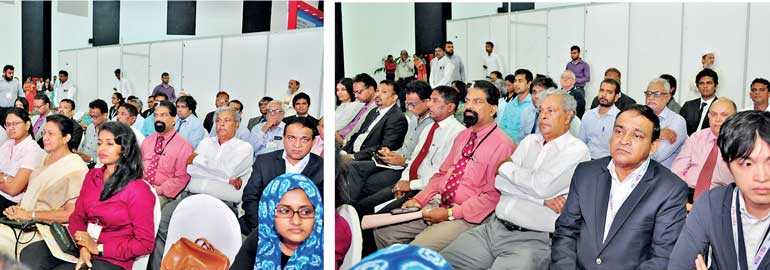Tuesday Dec 23, 2025
Tuesday Dec 23, 2025
Friday, 11 May 2018 00:00 - - {{hitsCtrl.values.hits}}



Apparel industry leaders, together with a Minister, said that increasing apparel exports and receiving trade benefits such as the GSP Plus facility should not blind the sector and it should move on and face emerging challenges to advance to the next level.
“After regaining GSP Plus, our apparel exports increased and we are now eagerly looking forward to surpassing the $ 5 billion annual exports value this year compared to the $ 4.8 billon in 2017,” said Industry and Commerce Minister Rishad Bathiudeen, while addressing the launch of the 8th AISEX and FASE apparel industry sourcing expo at the BMICH on 10 May.
The three-day biannual event exhibits apparel industry tech and new trends to manufacturers and the next expo in this series is scheduled in 2020.
Minister Bathiudeen added: “Therefore we expect this year to be a breakthrough year for our world-class apparel sector. We can already see this new trend in our 2018 first quarter apparel export performance. In the first quarter of this year our total apparel exports increased by 4% to $ 1.26 billion compared to last year’s first quarter exports of $ 1.21 billion.
“Last year’s first quarter of $ 1.21 billion was actually an 8.2% decline from 2016’s first quarter apparel exports of $ 1.31 billion. Therefore we expect this year to be a breakthrough year and I commend our entire apparel sector for their great commitment and excellent performance. However, I wish to say that we should not be blind to the present and upcoming challenges for our apparel sector. It will be difficult for us to move to the next level without resolving these issues. Our annual apparel exports are close to $ 5 billion but we spend close to $ 4 billion to import the raw materials and therefore we need to improve on the imports bill on our apparel material sourcing.
“Europe is a key market but it is undergoing changes due to increasing unemployment and policy uncertainties after Brexit. The solution to overcome such possible market pressures is the continuous diversification of our apparel exports to new markets. Adopting sustainable manufacturing, market diversification, sourcing more from nearby locations such as SAARC countries, and switching to emerging technological trends can help us face these challenges.”
Sri Lanka Apparel Institute Chairman Prof. Lakdas Fernando issued a warning over the apparel sector’s optimism about regaining the GSP Plus.
“In my view GSP Plus is a transient popup for our apparel sector. This gain is only for a short period of time. We need to adopt strategic thinking to meet the challenges in the changing scenario. Even to get the best from GSP concession a lot needs to be done. The winds of change are rippling across global industries and it is very much evident in the apparel sector too - in CAT tech, digital printing and digital designs,” said Prof Lakdas.
Joint Apparel Association Forum Secretary General Tuli Cooray said that Sri Lanka was at a critical stage as the country was moving towards a very ambitious reform agenda.
“New export strategies, new facilitations and new maritime changes are brought in to eradicate poverty. In this process various industry sectors, including apparel, play a key role. A majority of our labour force is in this industry and this sector is also a major contributor to our GDP. Therefore, the so-called GSP Plus relief will offer you benefits for a very limited period of time. And we have to ensure that we (ourselves) will raise the bar to the next level through new skills and new technologies. Our industry should be exposed to new global trends to move forward.”
Europe is a key market for Lankan apparel. Last year Sri Lanka earned $ 2 billion from apparel exports to the EU, which was 42% of total apparel exports. In the first quarter of this year, Lankan apparel exports to the EU increased by 5.2% to $ 526 million in comparison to $ 500 million in the first quarter of 2017. Apparel exports to the US too increased by 5.1% in this year’s Q1 to $ 576 million, from 2017 Q1’s $ 548 million.
Pix by Lasantha Kumara